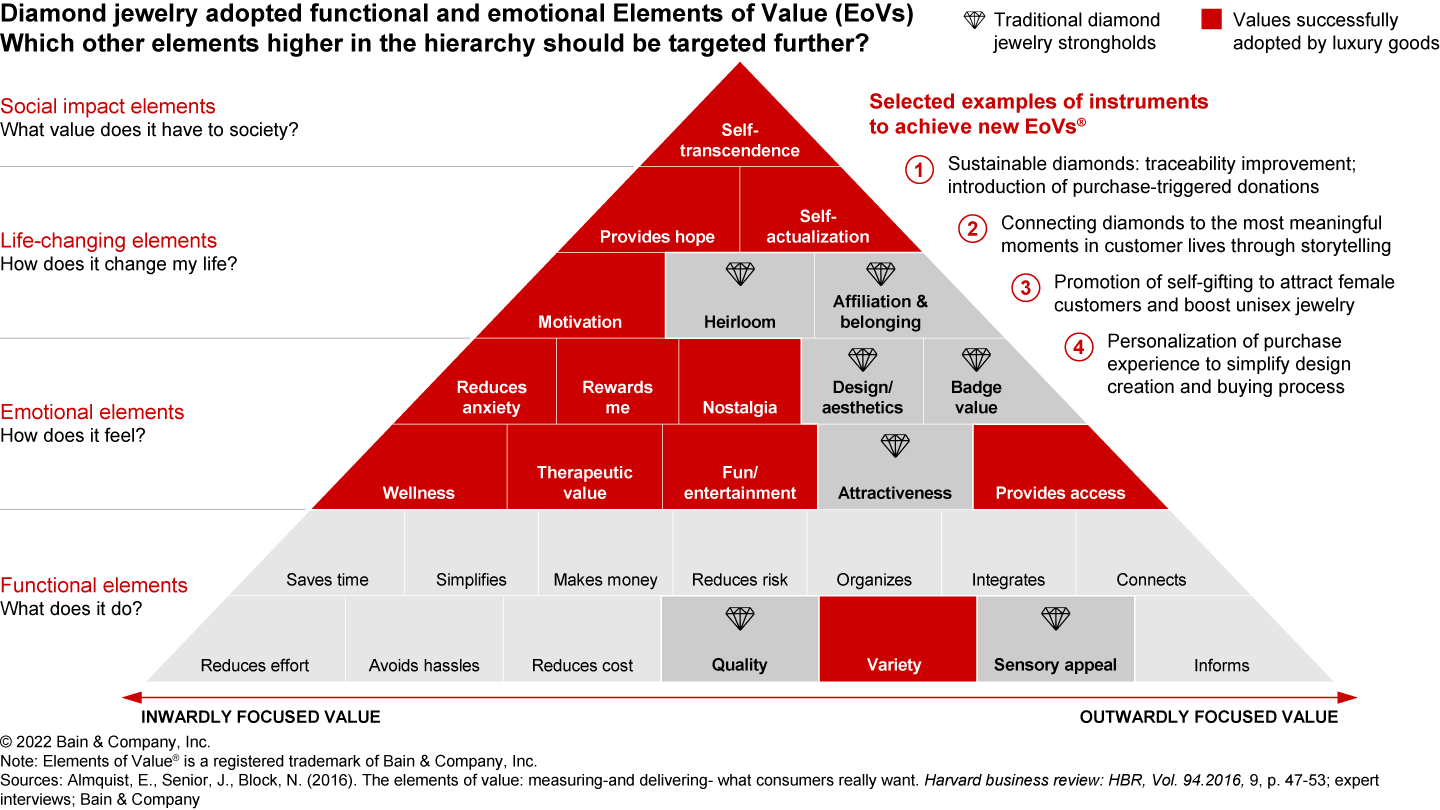Report

The past two years have been like riding a roller coaster!
Following rocky conditions in 2020, the diamond industry proved to be brilliant and resilient, and delivered a spectacular showing in 2021. Every sector of the diamond industry performed very well in 2021 and emerged from the Covid-19-induced crisis well-positioned for future growth. In 2020–21, the diamond industry invested heavily in technology to gain operational efficiency, create marketing and consumer experiences that attracted buyers, and accelerate e-commerce schemes. Even smaller mom-and-pop retailers added online sales platforms to reach consumers who couldn’t shop in person or travel due to government-instituted health measures.
And consumers were ready to spend. They were flush with cash from buoyant capital markets and economic stimulus programs, and eager to spend it on meaningful gifts for their loved ones (or rewards for themselves). Diamonds hit an emotional chord, which had been carefully cultivated by years of targeted marketing campaigns and storytelling. Diamond jewelry was also easier to access than other luxury and experience-based spending options.
Strong retail demand for diamond jewelry drove up prices and profit margins along the value chain. As rough diamond sales increased, miners increased production volumes and pulled from inventories to keep cutters and polishers busy. Healthy demand and price recovery for polished diamonds helped the midstream achieve decade-high margins.
In 2021, the industry had a renewed sense of value, which it answered through partnerships, consolidation, and technology. Now, every player along the value chain must add value—or remove hardship—on the path from mine to market.
What does the future look like? If we’ve learned anything this year, it’s that we can always be surprised. Our experience and history point toward two possible scenarios over the short- to mid- term, which we describe in this report—the 11th annual report on the diamond industry prepared by the Antwerp World Diamond Center (AWDC) and Bain & Company.
Read on for deeper discussion about the pandemic’s effects, the industry’s impressive recovery, and the possibilities ahead. It’s our pleasure to prepare and share this insight with you every year. We hope you find it helpful and interesting, and we welcome further discussions about our research and the implications for your company.

1. Recent developments in the diamond industry
- The diamond industry experienced a spectacular reversal of fortune in 2021. In 2020, diamond jewelry sales fell 14% and rough diamond sales declined 31%. Luckily, industry revenues rebounded faster than expected and quickly exceeded 2019 levels. In 2021, revenue increased 62% in the diamond mining segment, 55% for cutting and polishing, and 29% for diamond jewelry retail—all rising above pre-pandemic levels (+13%, +16%, +11%, respectively). The trend was consistent with previous economic downturns, when the diamond industry recovered with high double-digit growth within 12 to 18 months after a crisis peak.
- Demand for diamonds was strong throughout 2021, especially in the second half of the year. The year started with a strong Chinese New Year season and Valentine’s Day. In the second quarter, retailers placed orders earlier than usual to refill depleted inventories. Customers’ urge for emotional gifting, increased savings, limited availability of experience-based substitutes, and restricted travel boosted diamond jewelry purchasing. Demand grew even higher during the second half of 2021 in preparation for the winter holiday season.
- Strong demand for diamond jewelry and depleted inventories translated into price growth. Cutting and polishing players in India relaunched production in the first and second quarters of 2021 and started actively buying rough diamonds. Robust consumer demand, depleted inventories, and strong balance sheets in the midstream contributed to higher demand for rough diamonds across the entire assortment range. Even previously underperforming small and near-gem quality diamonds sold well. Overall, in 2021, after a fall in 2019 and 2020 of 7% and 11%, respectively, rough diamond prices grew by 21%. Prices for polished diamonds, which declined by 3% and 5% in 2019 and 2020, respectively, increased only 9% year over year. By the end of 2021, both rough and polished prices were close to pre-pandemic levels and historic averages but still below their historic maximums (20% below for polished and 26% below for rough diamonds).
- Profit margins across the value chain quickly recovered to pre-pandemic levels. Upstream margins increased roughly 9–11 percentage points (p.p.), reaching 2018–19 levels. The midstream and retail segments both achieved decade-high profitability, growing 3–5 p.p. and 6–8 p.p., respectively. Combined, mining and retail players generated $7 billion more profit in 2021 compared to 2020. This was a result of improved market conditions and operational excellence programs the industry undertook to combat lockdowns and competitive threats. The downstream also benefited from growth in more profitable regions, and an increase in online purchasing contributed to faster inventory turnover and lower operating costs.
- For the first time in several years, there was no shortage in diamond financing. With more liquidity, midstream players moved to cash sales and decreased their reliance on bank loans, reinvesting their profits into the business. Financial institutions, such as Guggenheim Partners, extended financing with confidence in the industry. Some larger traders shifted their focus, making finance provisioning one of their largest sources of income.
- Several trends continued on their pre-pandemic trajectories, namely, the divergence of lab-grown diamonds from natural-mined diamonds; emphasis on environmental, social, and governance (ESG) agendas; and beneficiation program development. Lab-grown diamonds continued to diverge into a separate, more affordable jewelry category. The segment saw continued demand growth and price decreases relative to natural-mined diamonds as lab-grown diamond supply increased and technologies advanced; the average polished lab-grown retail price declined to 30% and the average wholesale price to 14% of natural prices, down from 35% and 20% in 2020, respectively. ESG topics appeared on executive agendas across the value chain, with climate impact and origin transparency rising to the top. Both issues require cooperation between mining, cutting and polishing, and retail players. In 2021, African diamond- producing countries renewed beneficiation efforts. As more countries attempt to develop beneficiation programs, related cutting and polishing activities are expected to increase.
- Demand for diamond jewelry and polished and rough diamonds is expected to grow through the first half of 2022. The market expects a strong holiday season, strengthening consumer confidence in major markets, and limited supply of rough diamonds. In the medium term, demand for diamonds could be affected by government policies surrounding economic stimulus and consumer travel restrictions. Notwithstanding, in our base (“continued rebound”) scenario, in 2022 the market is expected to demonstrate growth higher than the pre-pandemic period and return to historic growth pace by 2023–24. Industry players must continue to pursue operational excellence programs, invest in digital technologies, and advance marketing concepts and the diamond jewelry value proposition to prepare for potential changes in market conditions.
Figures 1-5: Figure 1


Figures 1-5: Figure 2
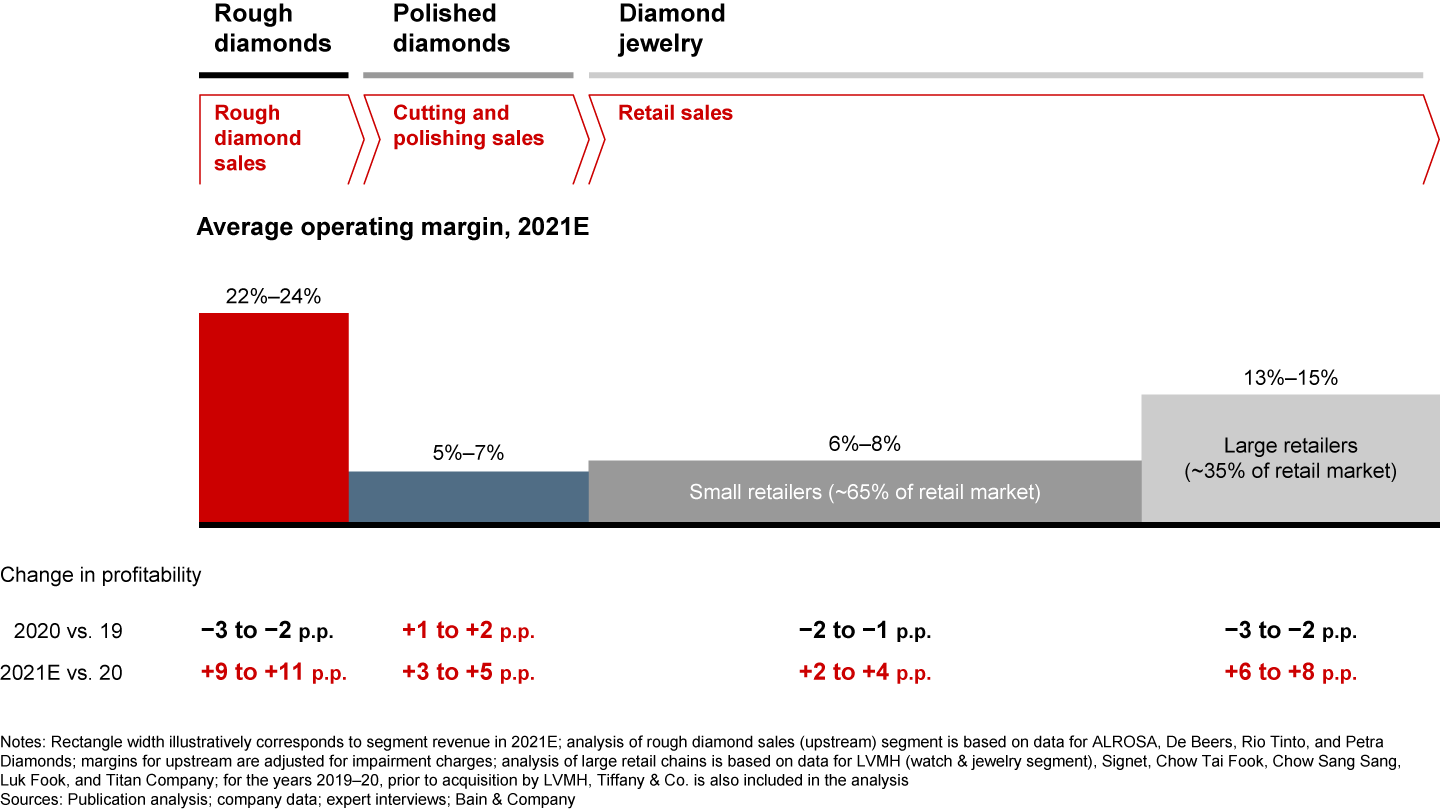

Figures 1-5: Figure 3


Figures 1-5: Figure 4
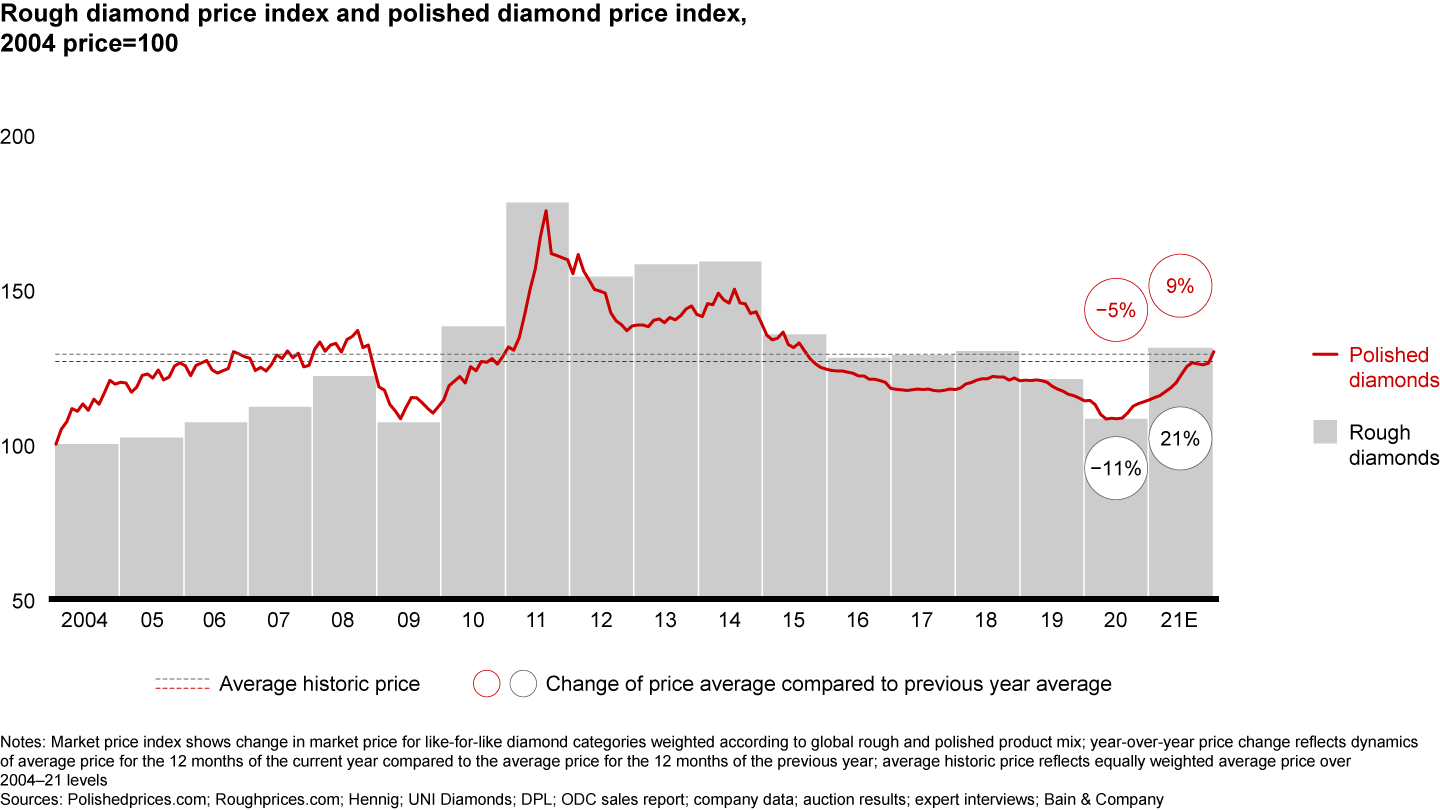

Figures 1-5: Figure 5
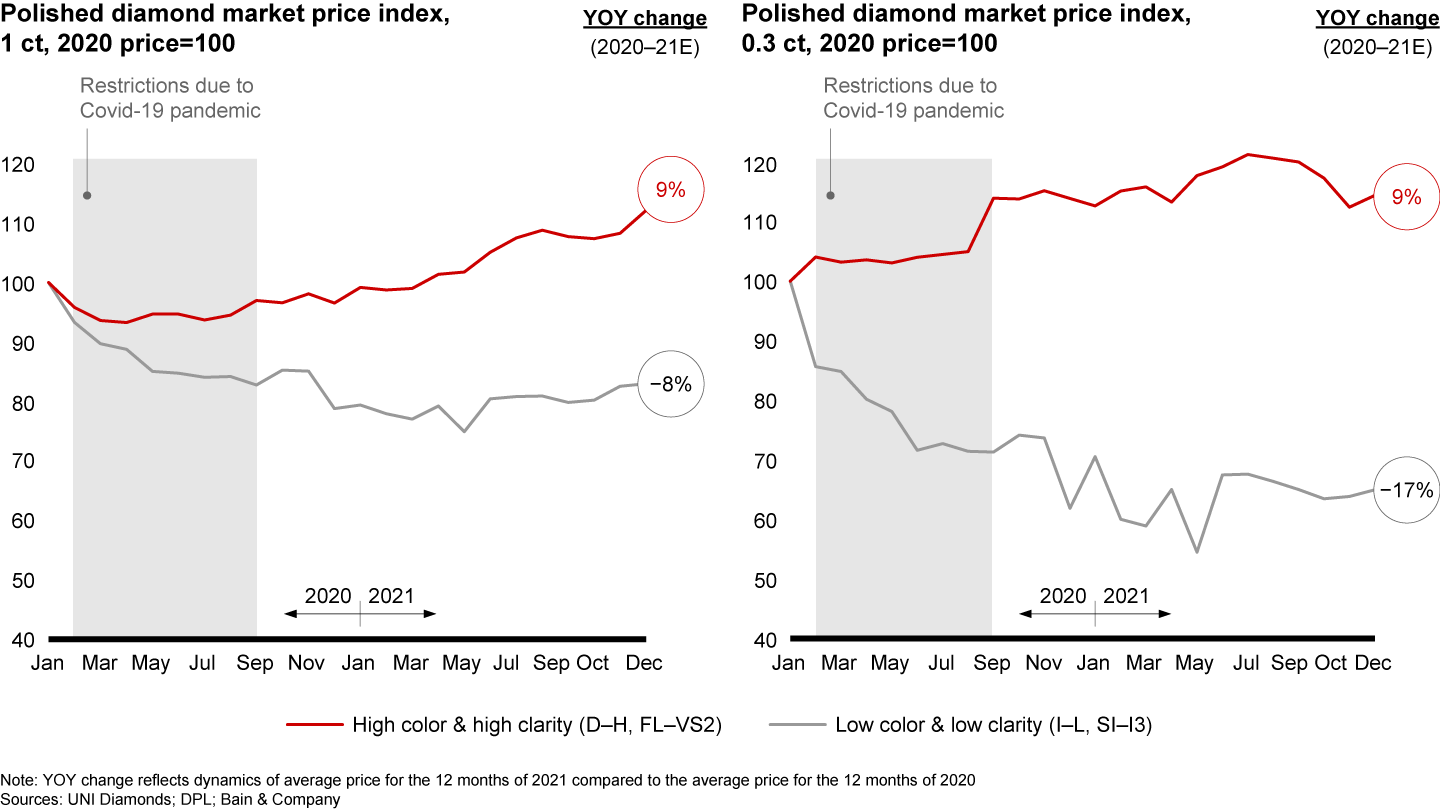


2. Rough diamond production
- In 2020, rough diamond production continued its steady decline, falling to 111 million carats. Lower production was a direct result of the Covid-19 pandemic. Most companies reduced or suspended production during the first half of 2020, with some restrictions lasting more than six months. To support the market, major mining players adopted a price-over-volume strategy, reduced sales volumes, and amassed record-high inventories. Even though the market started to recover in the second half of 2020, rough sales volumes were 20% lower and rough prices were 11% lower, which translated to a 31% drop in rough diamond revenue.
- Supply started to rebound in 2021. Net production grew 5% and reached 116 million carats, still 20% below pre-Covid levels in 2019. A 16-million-carat supply increase was offset by an 11-million-carat loss from the closure of the Argyle mine in November 2020. The majority of growth came from Botswana, Canada, Russia, and South Africa. In Botswana, a 5-million-carat improvement came from De Beers treating higher-grade ore at Jwaneng. In Canada, production renewal at Ekati and Renard contributed an additional 4 million carats. ALROSA increased output by 2.5 million carats by treating higher-grade ore at Botuobinskaya, increasing ore processing volumes at Nyurbinskaya pipe and Udachny mine, and resuming production at Aikhal mine and Verkhne-Munskoe deposit. De Beers’ South African production increased with the higher-grade ore from the final cut of the Venetia open pit.
- Rough diamond sales increased 62% in 2021. Miners increased production volumes and pulled from inventories to satisfy strong demand from cutters and polishers. Rough prices increased as midstream companies rushed to restock to meet growing demand. At the end of 2021, upstream inventories hit historically low levels—about 29 million carats, which is close to average technical stock levels. As a result of robust sales, rising prices, and cost-cutting programs in the first half of 2021, mining companies saw 9–11 p.p. improvements in margins on average.
- The year 2021 was rich with mergers and acquisitions and joint venture activity. Rio Tinto acquired the remaining 40% share of Diavik, becoming its sole owner. Rio Tinto also formed a joint venture with Angolan ENDIAMA to explore Chiri kimberlite in the Lunda Sul region of Angola. Gem Diamonds sold Ghaghoo mine in Botswana to a joint venture between Botswana Diamonds and Vast Resources. Lucapa purchased the Australian Merlin mine. Visionary Victor Resources purchased Firestone Diamonds’ Botswana operations (primarily its BK11 mine, which has been on care and maintenance since 2012). Perth-based Burgundy Diamond Mines acquired Ellendale mine in Australia, which was mothballed in 2015 but could restart fancy yellow diamond production by late 2022.
- ESG agendas continued to gain importance among investors and consumers. For mining companies, one of the most prominent topics on the ESG agenda is carbon neutrality. De Beers committed to reach carbon neutrality (Scopes 1 & 2 greenhouse gas [GHG] emissions) by 2030, and ALROSA is designing its climate and environmental strategies to decarbonize its operations. Both companies are investing in promising technology that enables kimberlite to absorb carbon dioxide.
- Traceability is another priority for mining companies. In response, De Beers is launching a Code of Origin program supplemented by its Tracr platform, ALROSA is developing noninvasive laser marking technology, and many companies are partnering with third-party traceability solution providers. ALROSA, AGD Diamonds, and Lucara are working with Sarine to give buyers the ability to trace the origin of their diamonds.
- Production is expected to hit 120+ million carats in 2022 but is unlikely to reach pre-pandemic levels within the next five years. The largest short-term threat is new coronavirus strains (e.g., the omicron variant) that might disrupt production and logistics again. Major new projects have not been announced and investments in exploration are limited, so production growth will likely stay at 1% to 2% per year during the next half-decade. Promising demand growth and production scarcity support stability or further price growth for rough diamonds.
Figures 6-10: Figure 6
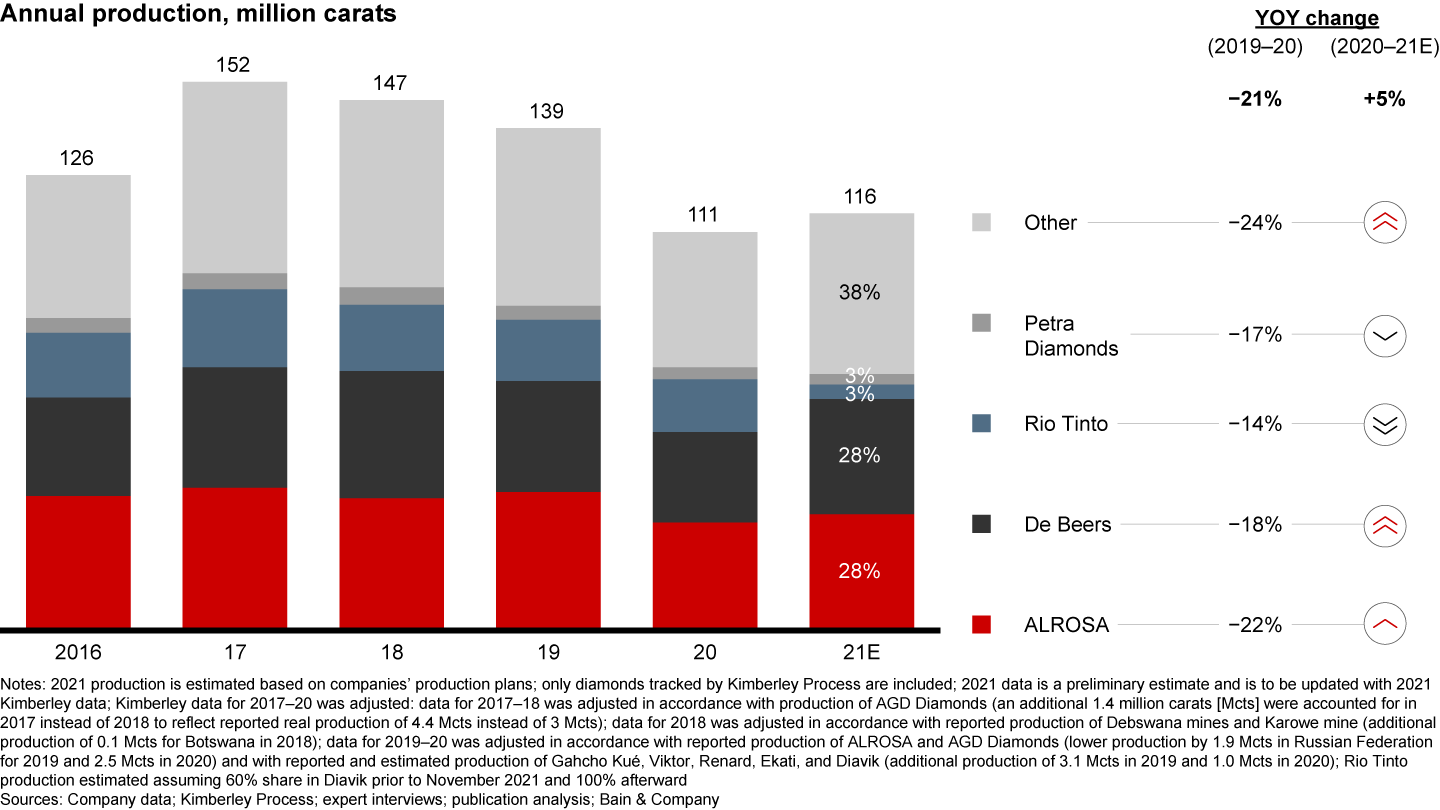

Figures 6-10: Figure 7
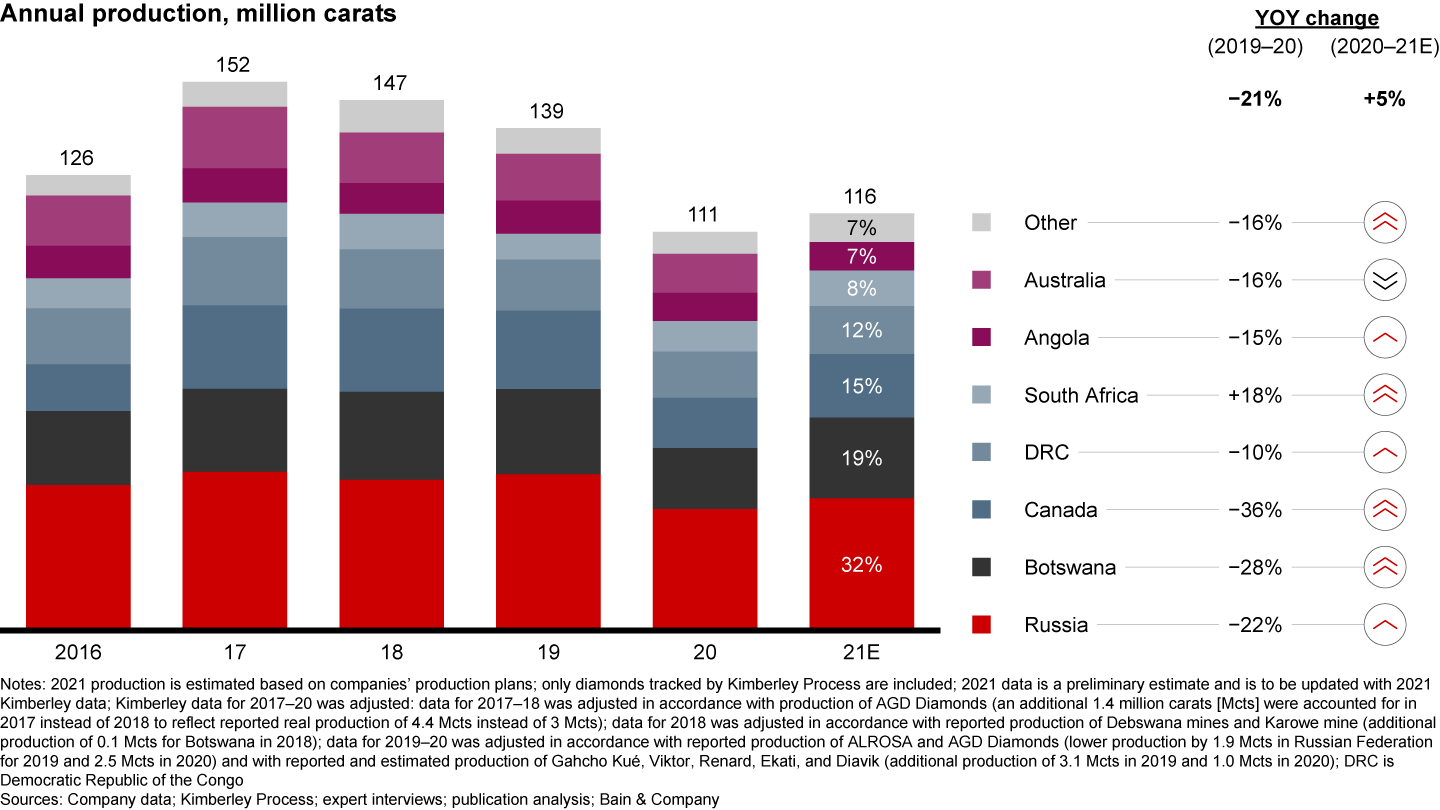

Figures 6-10: Figure 8
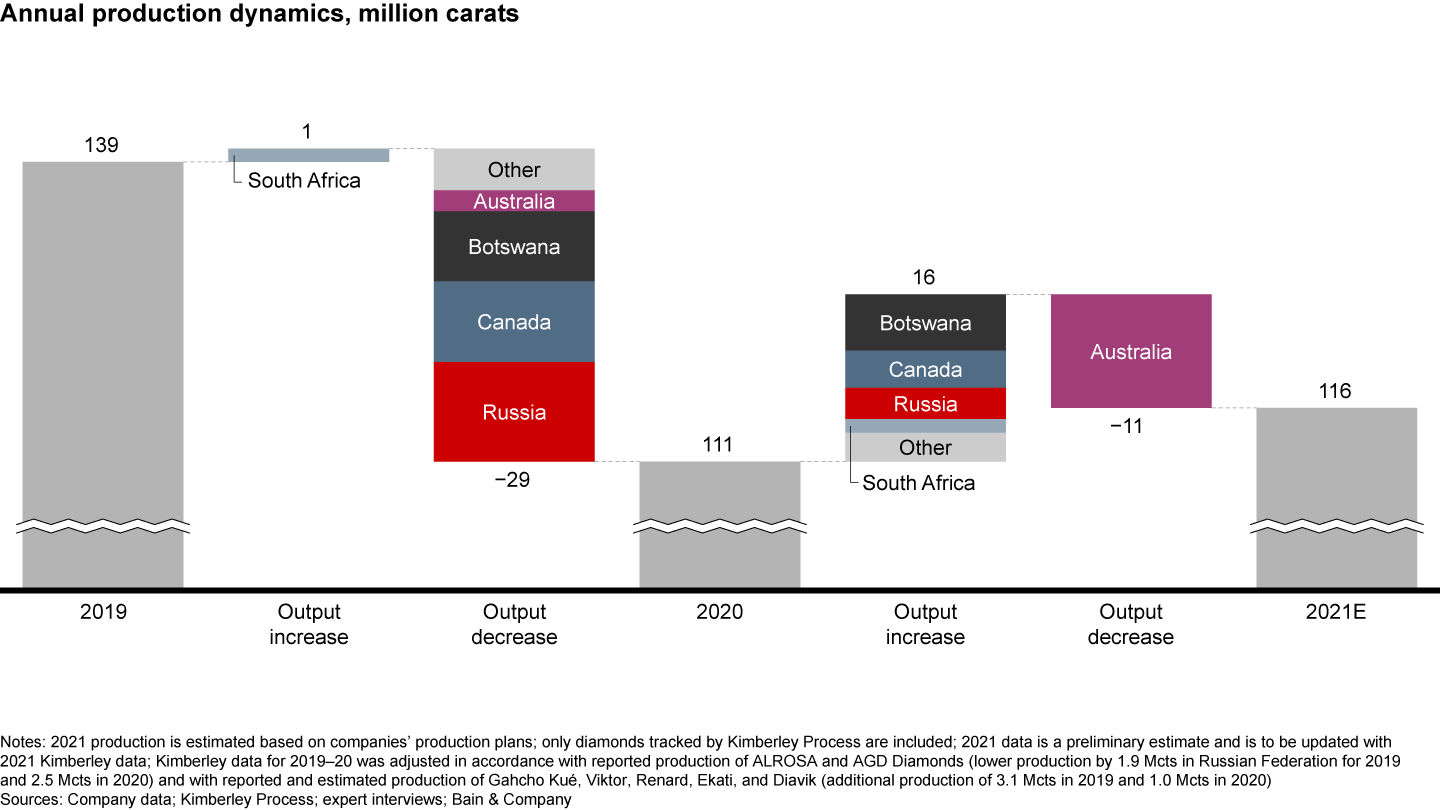

Figures 6-10: Figure 9
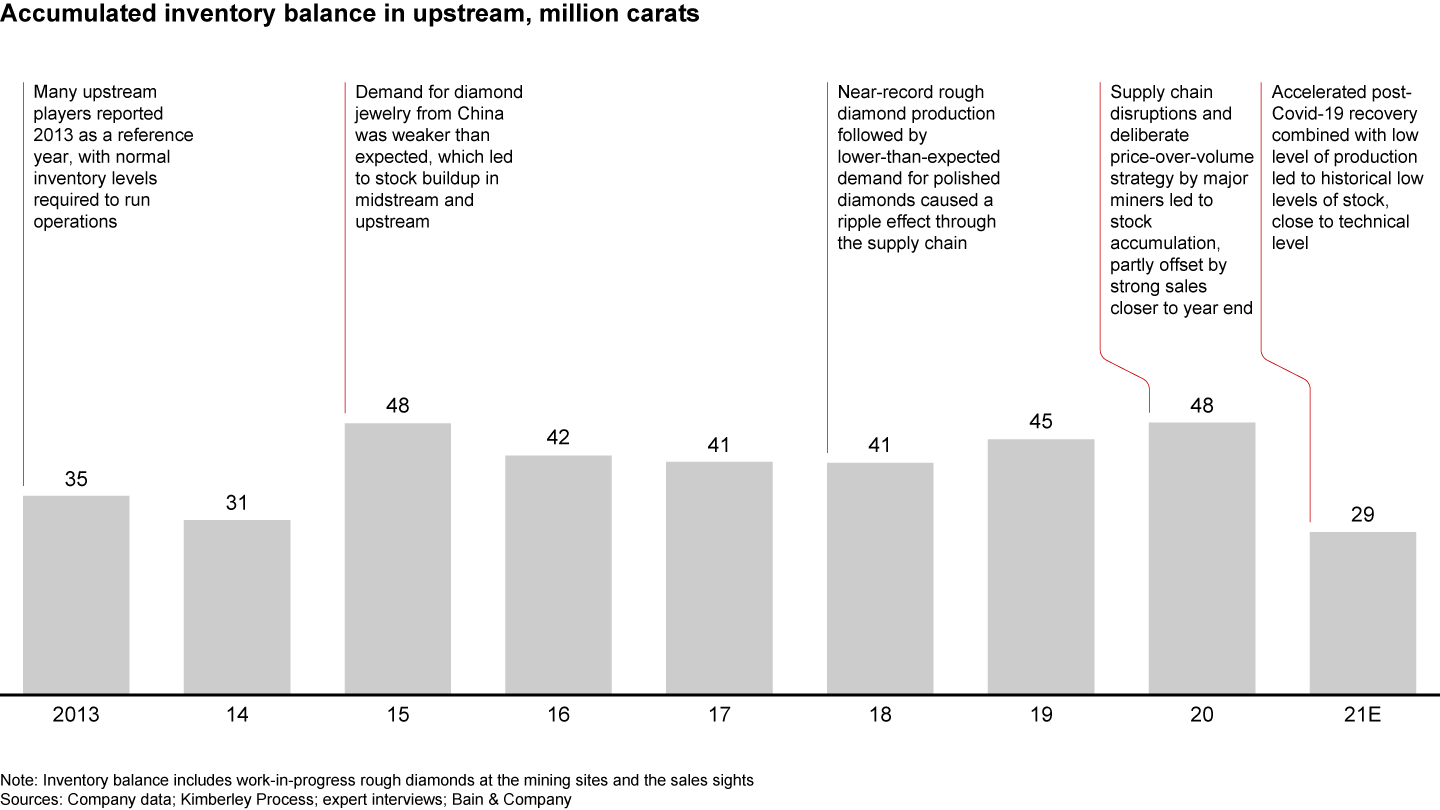

Figures 6-10: Figure 10
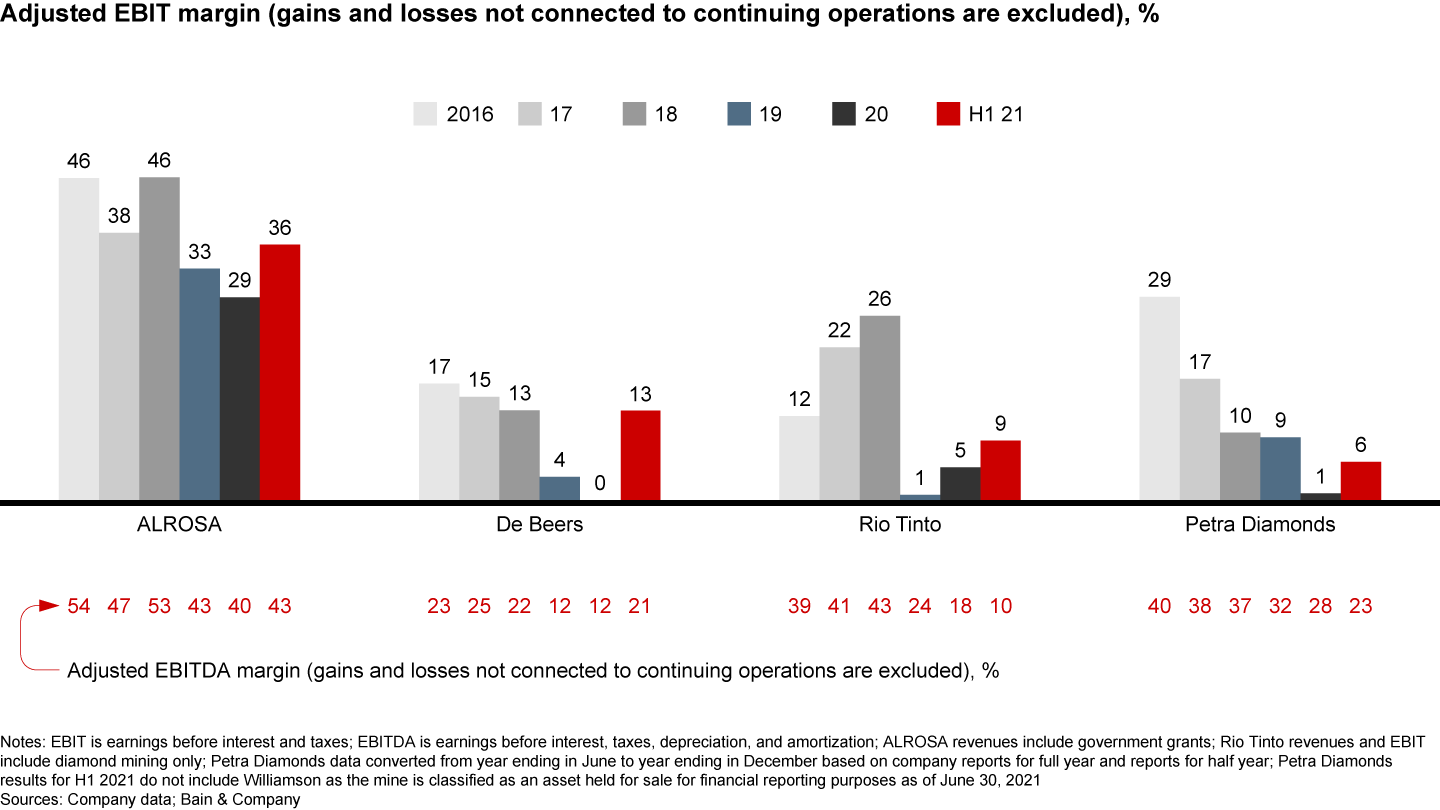


3. Cutting and polishing
- In 2020, cutting and polishing revenue fell 25%. Three factors contributed to the decline: disruption of the operations and logistics across the value chain, decline in jewelry sales due to lockdowns, and reduction in the prices of polished diamonds by 5%. A stronger-than-expected holiday season prompted early demand recovery and helped midstream players finish 2020 on a more positive trajectory. Despite the challenging start of the year, toward the end the midstream delevered excess inventory and improved profit margins 1–2 p.p. from 2019 levels.
- Healthy demand and polished price recovery turned 2021 into a lustrous year for the midstream and delivered decade-high margins. Demand was driven by swift economic recovery globally, increased interest in diamond jewelry in the US, as well as retail footprint expansion in smaller Chinese cities. Polished diamond sales rose 55%. The biggest winners were players with enough cash to buy rough diamonds at steep discounts (30% to 40%) between March and September 2020. Those companies had enough inventory for the market resurgence in 2021. Most of the rough diamonds bought in 2020 were sent to cutting and polishing centers in the beginning of 2021, building back the depleted rough stocks. As a result, rough diamond imports in India significantly surpassed rough diamond sales in 2021.
- In 2021, Indian cutters and polishers increased their net rough purchases by 94% to satisfy strong demand from retail. After severe lockdowns in 2020, India’s factories reopened to replenish inventories and meet growing demand. A second wave of Covid-19 lockdowns temporarily decreased labor availability from April to June 2021. But the shortage was mitigated by vaccinations, migrants returning to work after seasonal kharif sowing, and social distancing measures.
- Chinese cutting and polishing activities grew 43% in 2021 but did not reach pre-pandemic levels. China’s jewelry market recovered rapidly, driving an increase in imports of rough diamonds. However, labor shortages and difficulties in accessing rough diamonds due to travel constraints drove up the cost of manufacturing. Combined, those factors led to competitors from India taking even more market share from manufacturers in China.
- For the second year in a row, Antwerp increased its cutting and polishing activities to meet the demand for high-end goods. Labor costs and labor shortages remain a major barrier for growth.
- The year 2020 exacerbated the need for improved efficiency. Companies sought technologies to gain higher yields, increase manufacturing efficiency, lower labor costs, and enable traceability. Major players are also benefiting from dynamic pricing tools and the ability to customize offerings on their own digital platforms. Automatic cutting and polishing was a hot topic in 2021. Most advanced players are experimenting with Synova’s DaVinci Diamond Factory, FENIX, Galahad Compass from Lexus/OctoNus, and OGI Solico machines. The tools have high costs and low technological maturity so far, so players with access to cheap labor are not expected to switch in the short term.
- Trends toward consolidation and removing intermediaries continued in the midstream segment. Major mining companies redistributed rough diamond sales allocations to the largest polished diamond manufacturers, integrated retailers, and major dealers of specific assortments, moving away from non-value-adding traders and dealers to minimize speculative sentiment. Online sales of polished diamonds via manufacturers’ proprietary online platforms further reduced the need for intermediaries.
- Two other major trends continued to develop: beneficiation and mine-to-market partnerships. Beneficiation programs in Africa expanded successfully and improved transparency. Partnerships are becoming more popular as well. In 2021, wholesaler Samir Gems and jeweler Taché Company agreed to fund Meya Mining in exchange for rights to its products. Retailers also pursued midstream partnerships to get exclusive rights to special diamond cuts. New teaming efforts added to existing profit-sharing partnerships, such as those between Lucapa Diamond Company and Safdico International and between Lucara Diamond Corp. and HB Antwerp. These manufacturers are also teaming with high-end retailers, such as Graff Diamonds and LVMH.
- In 2022–23, we expect midstream performance will be largely influenced by diamond jewelry retail performance, expectations for continued growth in demand and consumer sentiment, and access to a limited supply of rough diamonds. Polished diamond top line is expected to follow retail sales dynamics, which in turn are influenced by physical retail footprint expansion and e-commerce development. Vaccine rollout and government economic responses will influence consumer sentiment. Regardless of the market situation, midstream players that have secured access to primary rough supply via partnerships or sightholder agreements and that invest in new technologies and optimize sales operations will benefit the most. It will be important to watch out for the direction in rough and polished prices. The gap between rough and polished prices will define overall midstream segment profitability, the effect of which we will see in full by mid-2022.
Figures 11-12: Figure 11
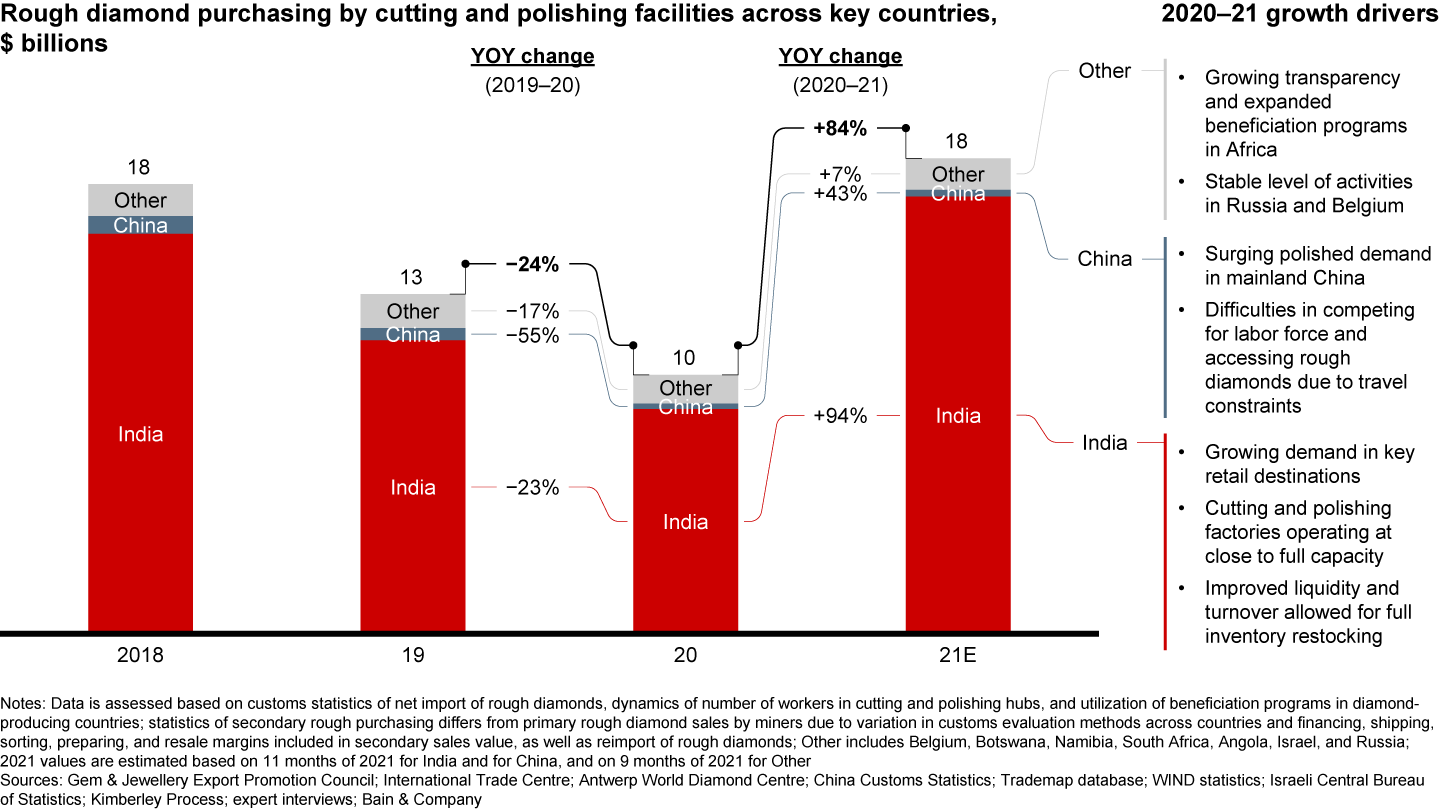

Figures 11-12: Figure 12
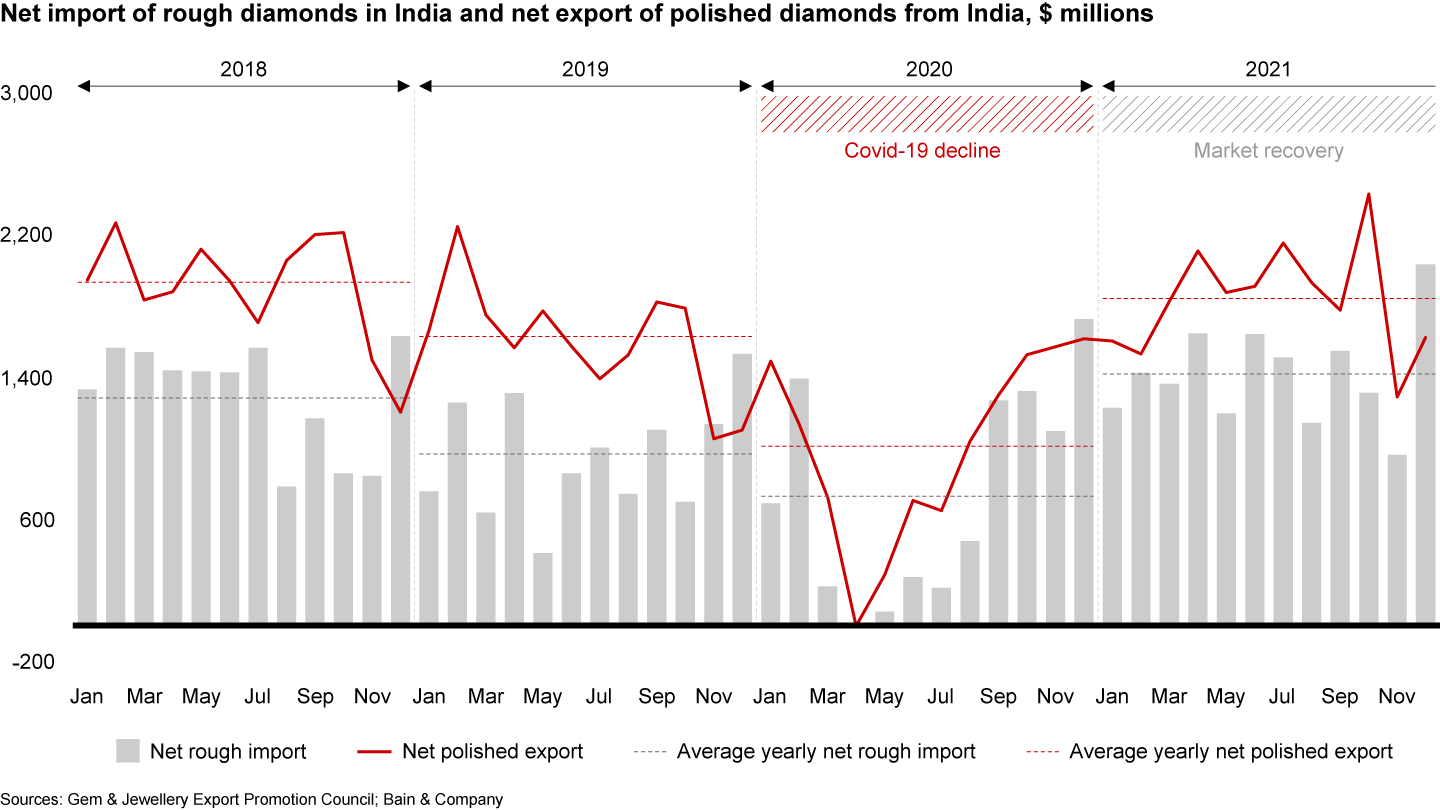


4. Diamond jewelry retail
- Diamond jewelry sales decreased 14% in 2020 because of store closures, wedding cancellations, and travel restrictions. In China, strong local consumption helped demand recover in the second half of the year. The US market started to recover in the third and fourth quarters. In China and the US, consumption declined 11%.
- In 2021, the personal luxury and diamond jewelry markets experienced decade-high growth (+35% and +29%, respectively). Diamond jewelry sales rebounded as Covid-19 restrictions relaxed and experience-spending opportunities remained low. Marketing and a resurgence of wedding demand also lifted sales. Coronavirus variants and new lockdowns dampened consumer optimism but were largely offset by vaccination rollouts in key diamond-consuming regions.
- In 2021, diamond jewelry retailers expanded their assortments to address a growing trend of sustainable jewelry. In addition to traceability programs, companies experimented with recycled and pre-owned jewelry. Tiffany & Co. launched a new product line made from recycled gold, and Signet released a collection of reclaimed gold and repurposed diamonds. Top retailers also adopted pre-owned jewelry sales through new lines and acquisitions. Blue Nile relaunched myGemma, a collection of pre-owned, high-quality engagement rings, and Kering purchased a 5% stake in Vestiaire Collective, an e-commerce platform for pre-owned luxury items.
- US retail fared best, with 38% growth in year-over-year diamond jewelry sales and 23% growth relative to 2019. Macro factors—including a substantial economic relief package (37% of GDP), unemployment rate reductions, a stock market surge (30%), and vaccinations—boosted consumer confidence and spending in 2021. Consumers had an emotional urge to spend the savings they accumulated in 2020, but experience-based gifting options were limited. The pandemic rapidly accelerated e-commerce, even for independent US retailers: 90% of jewelry retailers now have online platforms. Retailers optimized brick-and-mortar footprints by closing underperforming, mall-based stores and expanding off-mall locations that were less vulnerable to Covid-19 containment measures. The promotion of diamonds also increased a notch. Tiffany & Co. engaged Beyoncé and JAY-Z to star in its “About Love” campaign, and the movie House of Gucci featured a large diamond jewelry wardrobe.
- In China, diamond jewelry retail increased 19% year over year, exceeding its pre-Covid-19 level by 6%. China had the most successful vaccination program globally, vaccinating 85% of its population. Registered marriages increased 8% in 2021 but stayed below 2019 levels, leaving room for growth. The National 14th Five-Year Plan unleashed large spending potential in lower-tier cities and suburban areas. Retailers responded by adding physical stores in lower-tier cities and switching to corner-store formats in residential locations. Retailers also joined online marketplaces, such as Pinduoduo. Livestreamed sales on social networks, such as Weibo and TikTok, supported growth; jewelry accounted for 20% of livestream sales revenues. Online channels stimulated diamond sales in lower-tier areas with limited retail footprints. The largest retailers invested in “smart retail” projects, such as personalized jewelry design and instant online customer assistance, and optimized and automated their inventory distribution processes. Smart retail attracted more Gen Z customers, who are price-conscious and interested in sustainability. Special collections (e.g., Forever Young 88 and Guardian of Life by Chow Tai Fook) also targeted younger audiences and the solitaire market.
- In India, diamond jewelry sales rose 16% in 2021, following a 25% drop in 2020. Sales stayed 13% below 2019 levels, though. Competing dynamics defined the diamond jewelry demand in 2021. Lockdowns in the first half of 2021 and a reduced flow of travelers from Gulf countries restrained India’s recovery. In the second half of 2021, the vaccination rollout reinvigorated consumer confidence. A 57% increase in weddings released pent-up demand for bridal jewelry. At the same time, festive jewelry suffered as two-thirds of major festival celebrations were canceled during lockdowns. Sales at mom-and-pop shops sharply declined due to customers’ expectations for heightened safety measures and hallmarking compliance. National and regional organized retailers took the opportunity to expand into Tier-3 and Tier-4 cities, driving overall diamond retail.
- In Europe, diamond jewelry retail only partially recovered in 2021. It grew 18% but did not reach pre-pandemic levels, remaining 5% below 2019 retail sales. In the first half of 2021, easing Covid-19 restrictions supported the recovery. Europe’s consumer confidence index grew 25%, indicating households’ intentions to make major purchases. However, a new wave of lockdowns for unvaccinated people during the third quarter slowed the recovery, exacerbated by uneven vaccination rates (30% to 84%) across European countries. Reduced international tourism, especially from China, also affected the recovery.
- In the short term, downstream performance will depend on further economic growth perspectives and industry-specific factors, such as rebound of wedding celebrations with the ease of pandemic restrictions. New Year’s, Valentine’s Day, and Chinese New Year sales, as well as government responses to new waves of Covid-19, will set the tone for 2022.
Figures 13-20: Figure 13
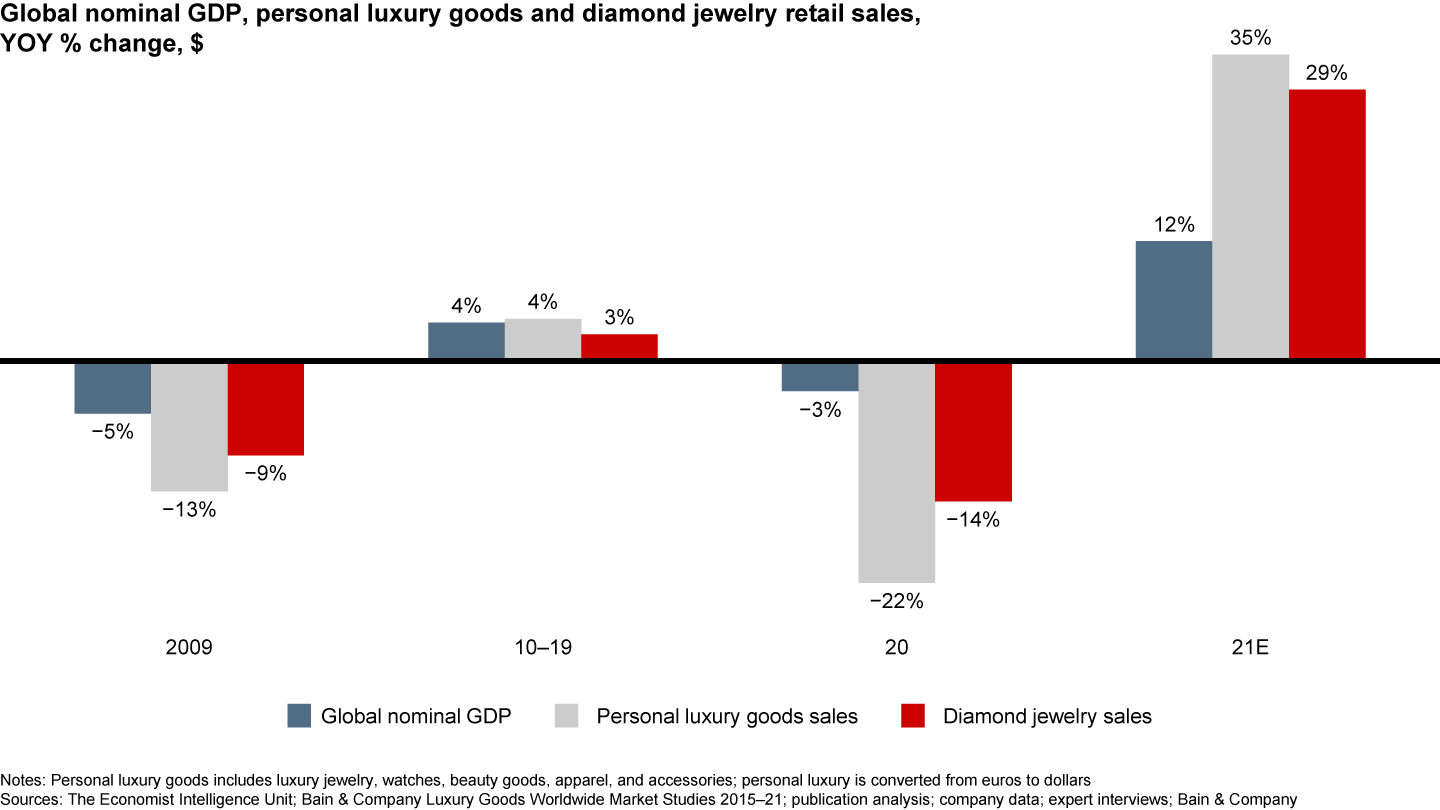

Figures 13-20: Figure 14
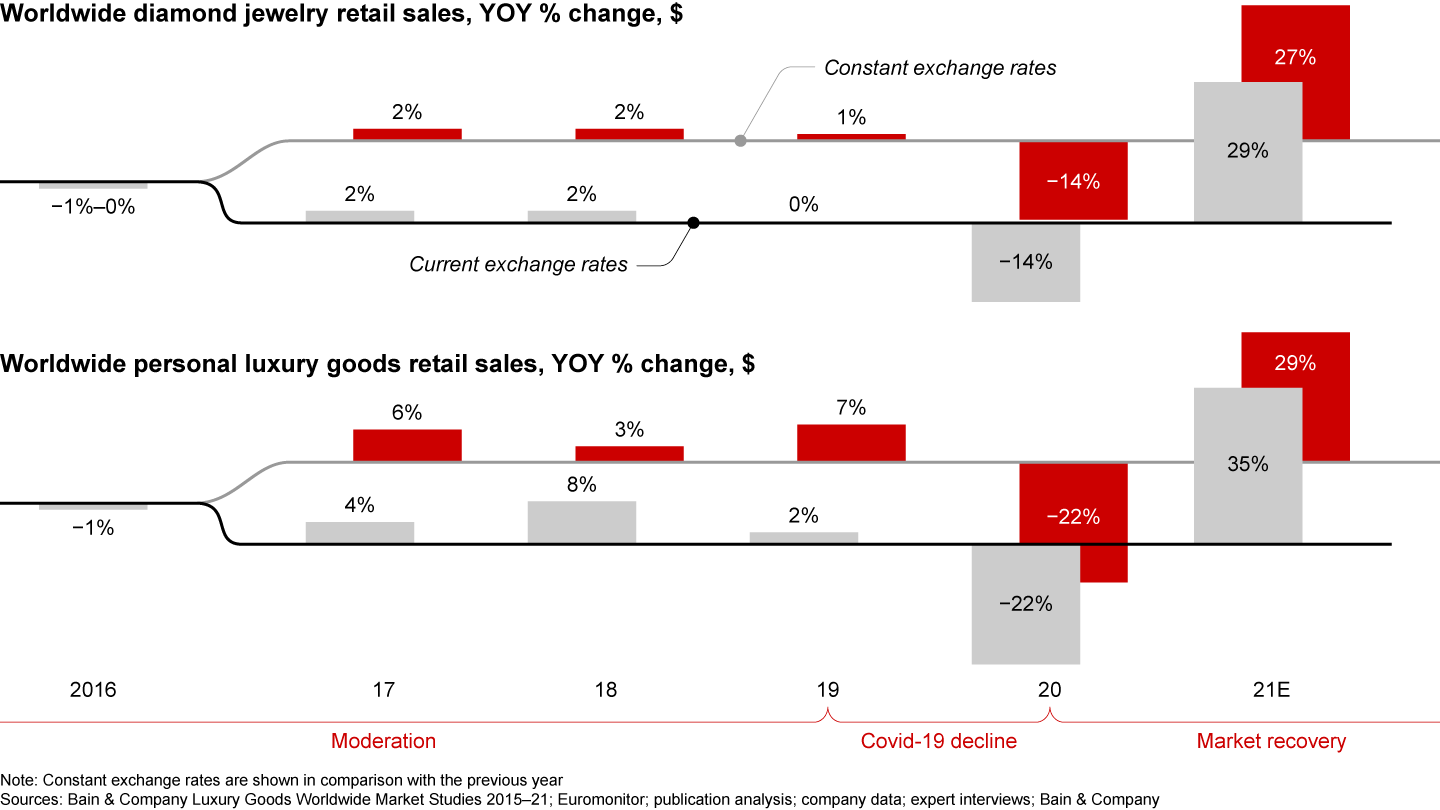

Figures 13-20: Figure 15
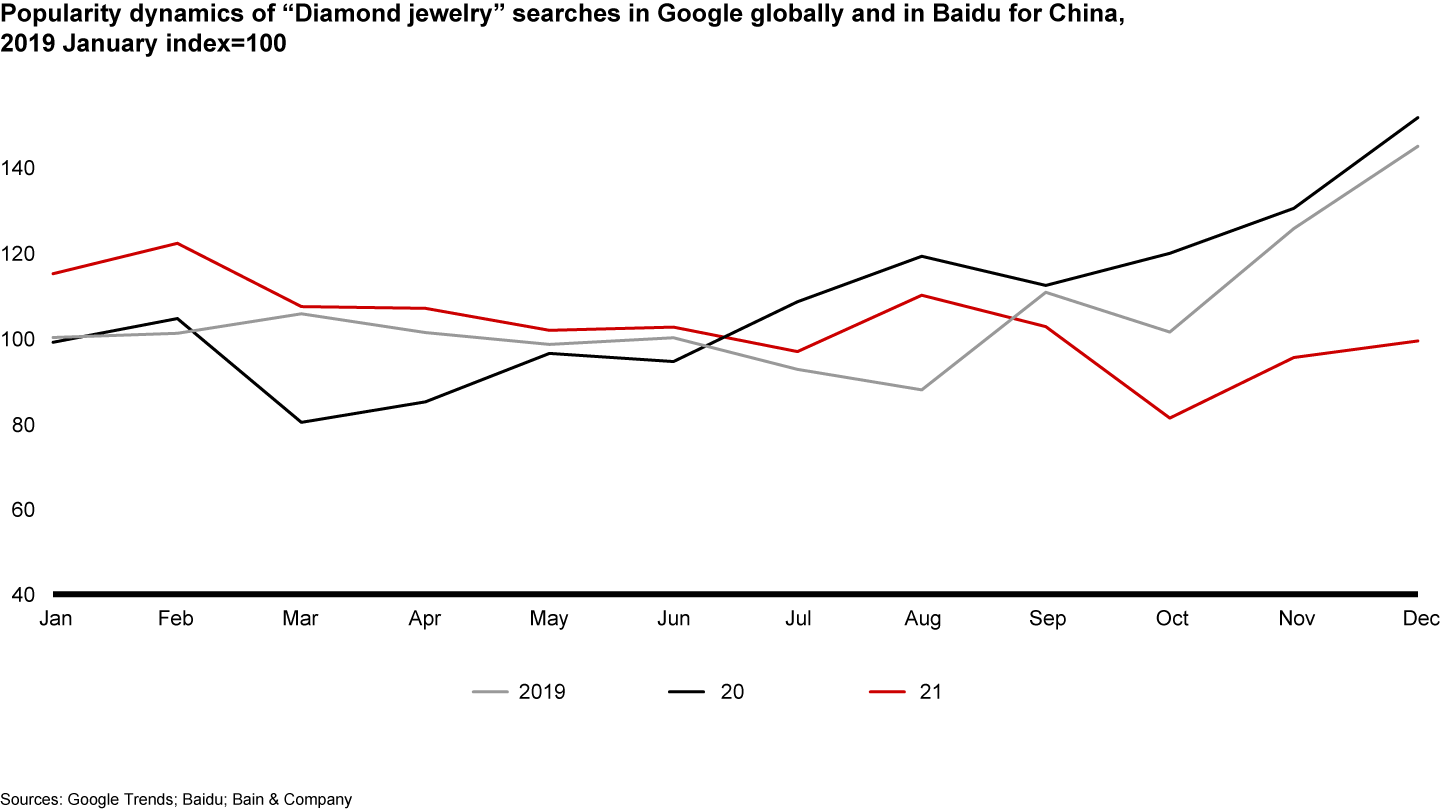

Figures 13-20: Figure 16
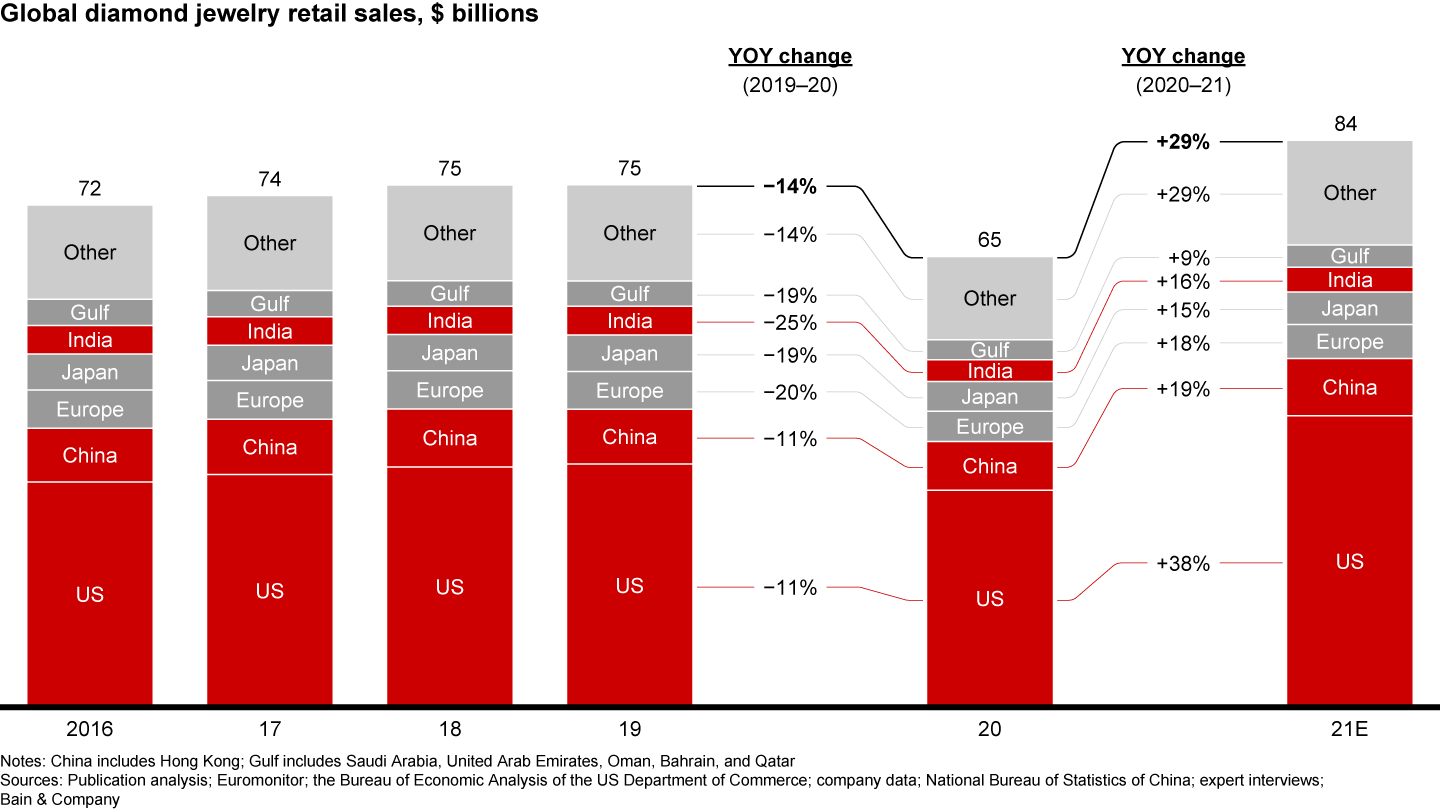

Figures 13-20: Figure 17
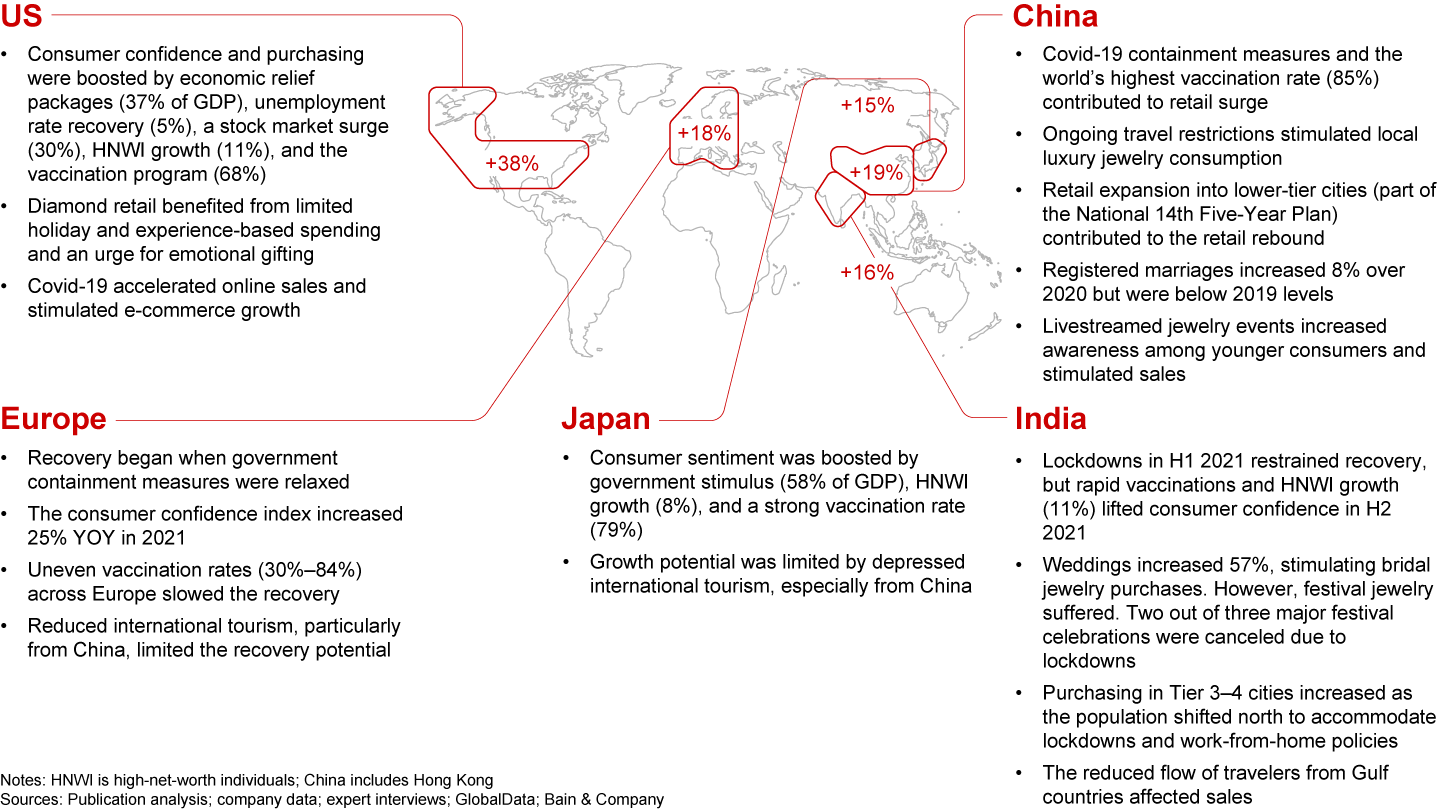

Figures 13-20: Figure 18
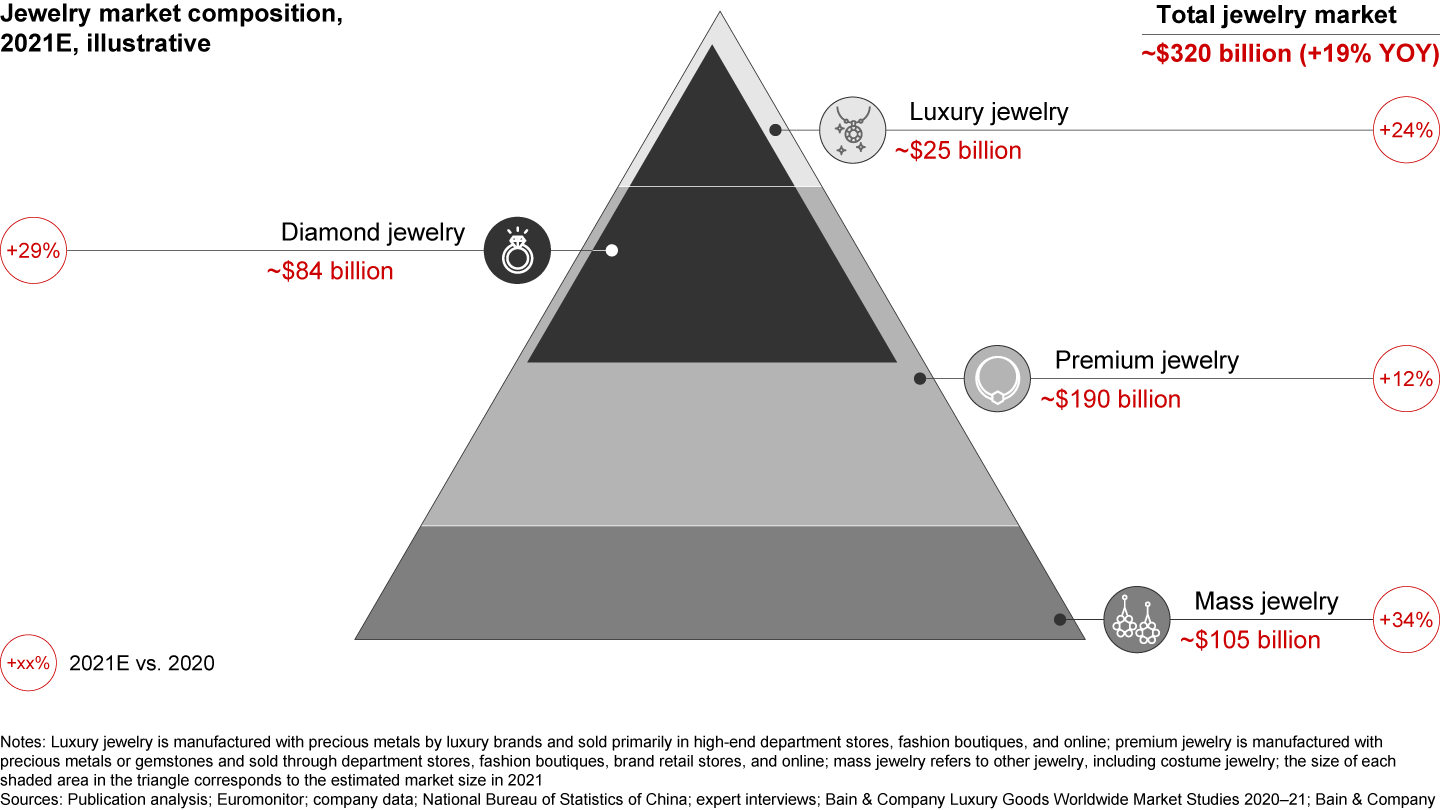

Figures 13-20: Figure 19


Figures 13-20: Figure 20
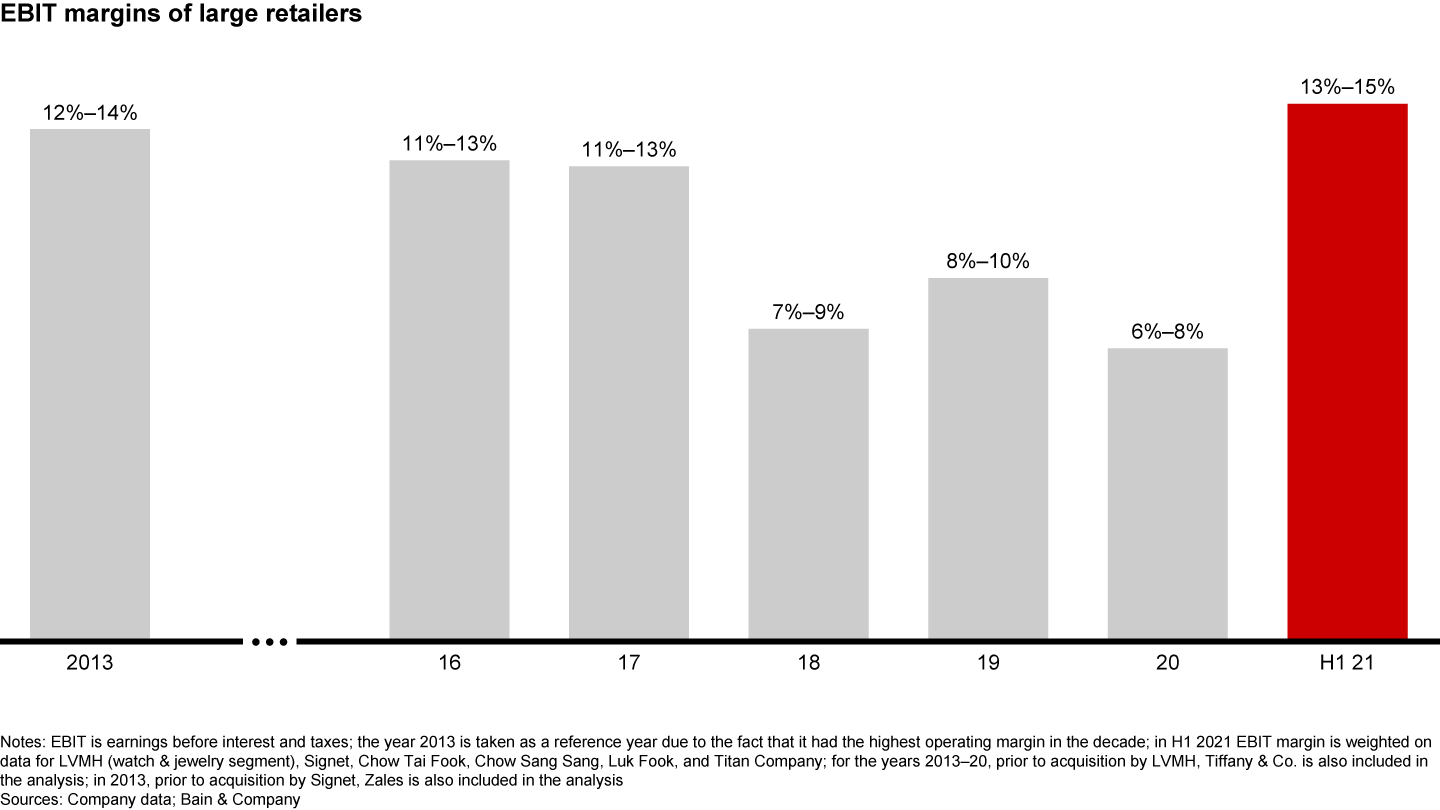


5. Midterm forecast
- The diamond market is expected to be strong through the first half of 2022, supporting growth across all segments. Two possible scenarios then emerge: “continued rebound” and “short-term readjustment.”
In the continued rebound scenario, the expectation is for the US and China to continue sustained growth momentum while other regions return to pre-pandemic levels, all supported by successful vaccination programs, limited lockdowns, and resumption of inter-regional travel. In this scenario, diamond jewelry sales are expected to continue to flourish, creating strong demand for polished stones. Continued growth in demand and limited supply of rough diamonds will benefit both miners and midstream players, supporting further strong price growth for polished and rough diamonds. Supply growth from the pre-owned jewelry market is also limited at least in the midterm: the initial retail mark-ups and pawnshops’ discounts should be offset by a sharp diamond price increase and trusted valuation mechanisms should be established in order to induce a significant supply of recycled diamonds.
The short-term readjustment scenario implies a possible slight correction in diamond jewelry demand starting toward the end of 2022 and the beginning of 2023, with a gradual return to pre-pandemic trend levels and growth rates in 2024—similar to how the diamond market strongly rebounded and then readjusted to its historic trajectory during past recessions.
The most likely scenario is closer to a “continued growth across all segments” outcome since the industry is in a much better financial position than it was during previous recessions. Inventory levels of diamond jewelry and polished and rough diamonds are also among the lowest and healthiest the industry has seen in the past decade. - Longer-term market trajectories will be shaped by traditional industry factors: affordability, desirability, value chain efficiency, and the buying experience. Diamond affordability relies heavily on the pace of economic growth and consumers’ disposable incomes. Desirability is reflected by the share of diamond jewelry sales within total jewelry and luxury consumption as well as cultural acceptance of diamond jewelry gifting. To achieve efficiency, the industry needs smooth inventory transition processes and price parity that allows all players along the value chain to earn sustainable profits that can be reinvested in marketing support and growth. The buying experience is shaped by access to diamond jewelry and omnichannel development.
- CEOs of businesses across the value chain are tackling an array of potential actions to position their businesses for long-term success. Diamond mining companies are investing in parcel consistency and technologies to enable efficient and effective online sales experiences in case of repeated disruptions in logistics. To address the growing desire for social impact, especially among younger consumers, mining companies are investing in various aspects of environmental and social issues, including traceability, transparency, and carbon neutrality.
Midstream players are focused on efficiency, reviewing their business models to facilitate flexibility, introducing demand management practices, rightsourcing, and direct-to-customer sales channels. Consolidation and automation efforts are also on the agenda. Diamond jewelry retailers are seizing the momentum to rethink gifting occasions and the role of diamond jewelry. From functional and sensory to aesthetic and emotional appeal, marketing needs to harness more of the inspirational, self-actualization, and motivational elements of the value proposition for diamond jewelry. Another important aspect of creating a winning value proposition for consumers lies in enhancing the overall customer experience—from researching to buying to owning diamond jewelry—through product innovation, storytelling, and “wow” omnichannel engagement. - In addition to individual company and brand actions, a coordinated and purposeful investment in diamond marketing is required for sustained long-term growth. Cross-value chain marketing efforts remain limited but are expected to grow. The Natural Diamond Council’s 2022 budget is expected to increase 33% (from about $80 million in 2021) following program expansion and the addition of new members. The drive to improve and expand diamond marketing has to continue as marketing investment in luxury products increases and becomes more creative. Diamond jewelry needs to keep pace to stay relevant and exciting for the next generation of consumers.
Figures 21-25: Figure 21


Figures 21-25: Figure 22
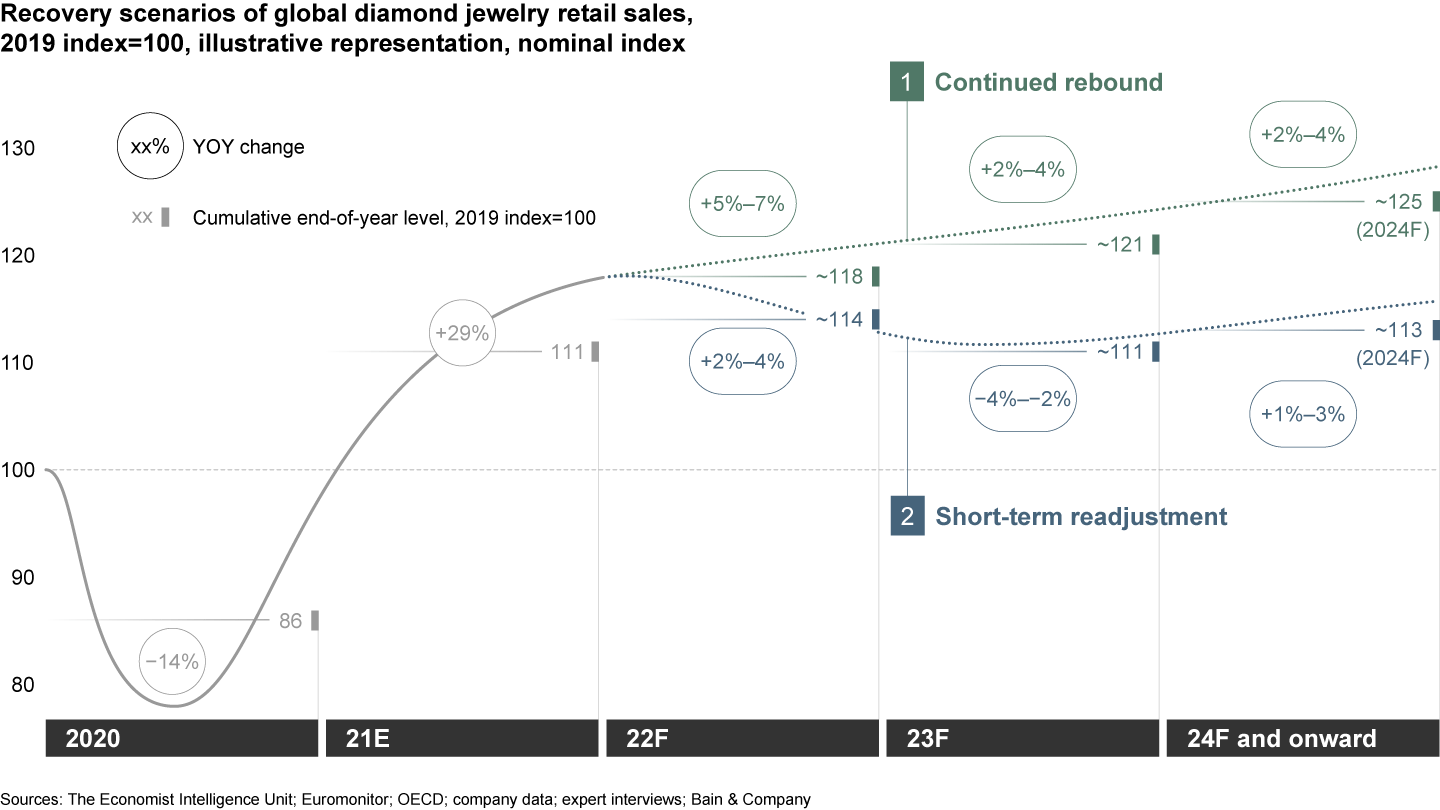

Figures 21-25: Figure 23
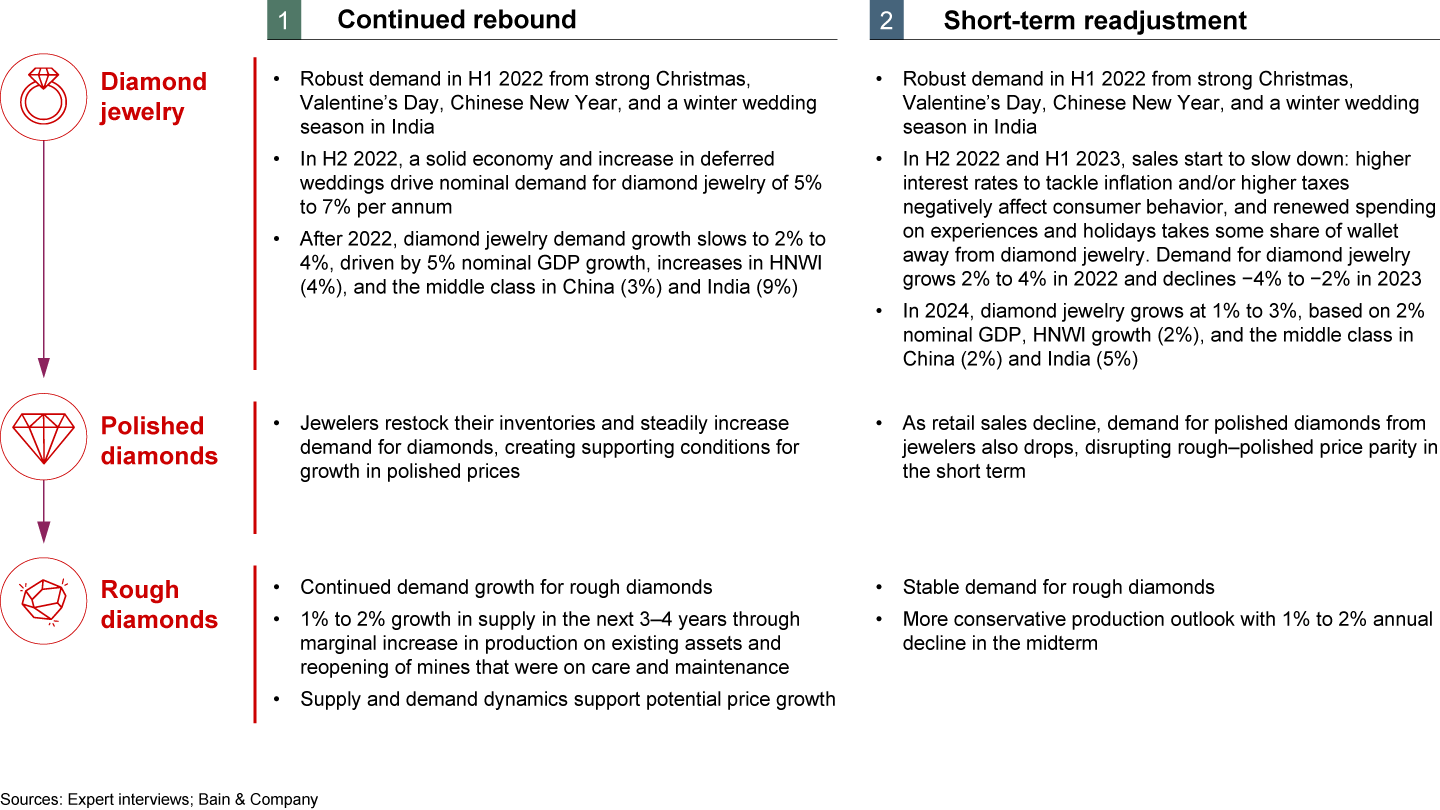

Figures 21-25: Figure 24
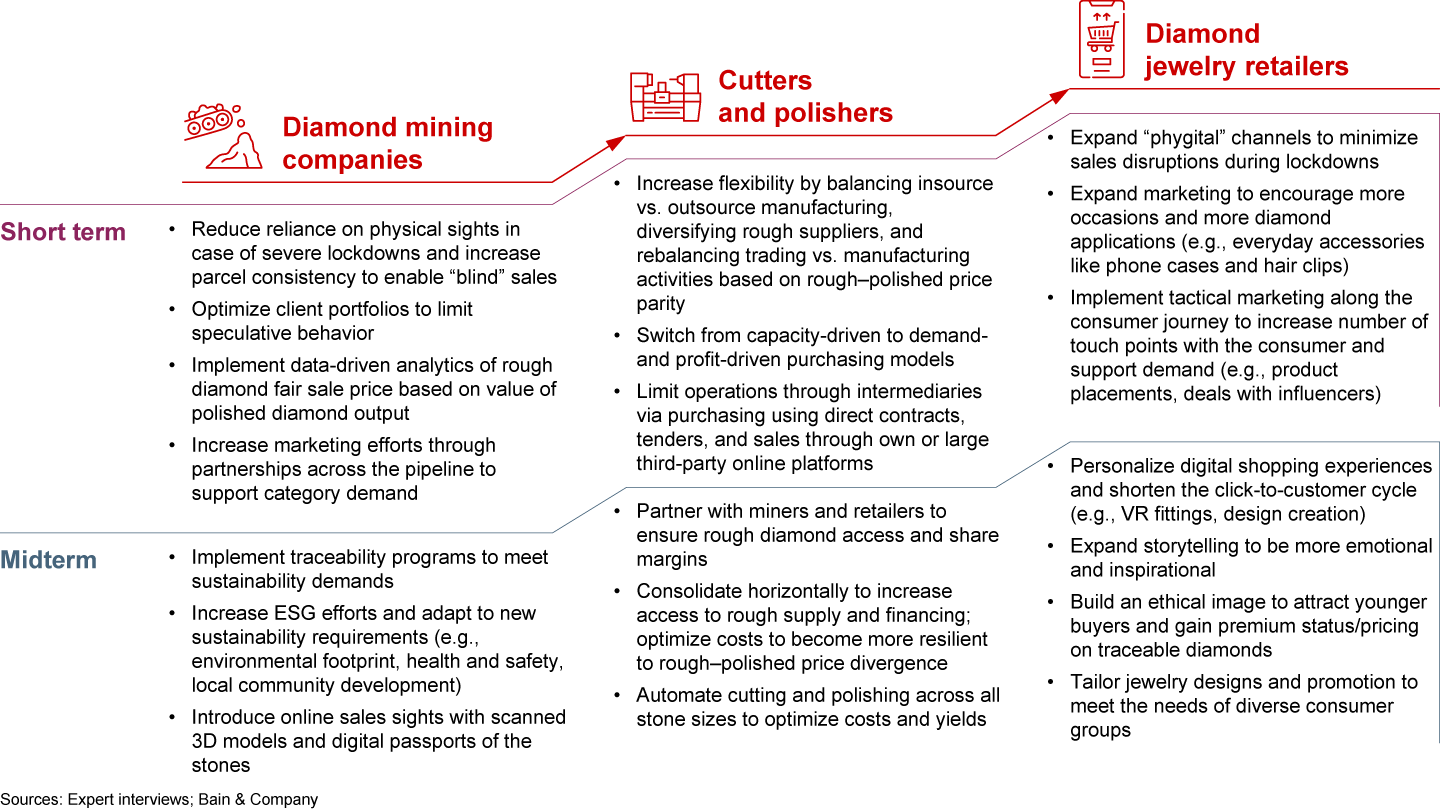

Figures 21-25: Figure 25
